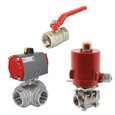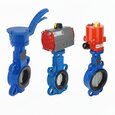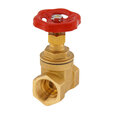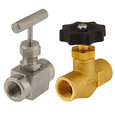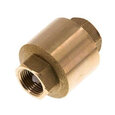IP rating chart & definitions
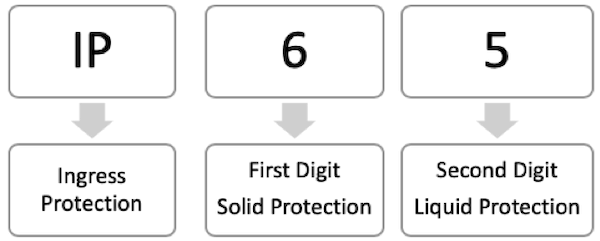
Figure 1: IP rating
The IP rating, also referred to as 'Ingress Protection' or 'International Protection' rating, indicates how well electrical enclosures are sealed against foreign substances such as accidental contact, dust, moisture, and liquids. These ratings are specified in the international standard EN 60529 (British BS EN 60529:1992, European IEC 60509:1989). IP ratings offer details on a device's ability to withstand dust or liquid penetration and the extent of its resistance.
Table of contents
View our online selection of valves!
First digit
The first digit in the IP rating denotes the degree of protection the enclosure provides against solid foreign objects like dust, accidental contact by hands, fingers, tools, wires, etc. The corresponding description of the digits are explained below:
| First digit: | Solid protection description: |
| 0 (X) | No protection |
| 1 | Protection against solid particle of diameter greater than 50mm |
| 2 | Protection against solid particles with diameter 12.5mm or more |
| 3 | Protection against solid particles with diameter 2.5mm or more |
| 4 | Protection against solid particles with diameter 1mm or more |
| 5 | Protection against dust particles |
| 6 | Dust tight; Full protection |
Second digit
The second digit in the IP rating defines the degree of protection against liquid intrusions. The following is a brief description of the corresponding digits.
| Second digit: | Liquid or moisture protection description: |
| 0 | No protection |
| 1 | Protection against vertically dripping water |
| 2 | Protection against dripping water when the enclosure is tilted up to 15° angle |
| 3 | Protection against spraying water up to angle of 60° from vertical |
| 4 | Protection against water splashing from any direction |
| 5 | Protection against directed water jets of low pressure (6.3mm) from any angle |
| 6 | Protection against directed water jets of high pressure (12.5mm) from any angle |
| 7 | Protection against full immersion up to the depth of 1m for 30 minutes |
| 8 | Protection against immersion up to greater depths and higher pressure |
| 9 (K) | Protection against directed water jets of high temperature and pressure, wash downs or steam cleaning procedures |
IPX rating
'X' seen in the IP ratings simply means that the value for the number is missing. The 'X' can simply be replaced with a zero considering no ingress protection rating has been provided. For example, IPX4 can simply mean that the enclosure provides no protection from ingress of solid particles but provides protection against water splashing from any direction.
IPK rating
'K' as seen in some IP ratings mean that the enclosure must provide protection against ingress of directed water jets of high temperature and pressure. For example, IP69K ratings are typically used in wash down environments like car wash, food and beverage application and other steam cleaning procedures.
IP rating chart
Following is a quick reference chart to help you decide on the IP rating enclosure of your requirement.
| No liquid protection | Protection against vertically dripping water | Protection against dripping water when the enclosure is tilted up to 15° | Protection against spraying water up to 60° from vertical | Protection against water splashing from any direction | Protection against directed water jets of low pressure (6.3 mm) from any angle | Protection against directed water jets of high pressure (12.5 mm) from any angle | Protection against full immersion up to the depth of 1 m | Protection against full immersion up to greater depths and higher pressure | Protection against directed water jets of high temperature and pressure | |
| No solid object protection | IP00 | IP01 | IP02 | IP03 | IP04 | IP05 | IP06 | IP07 | IP08 | IP09 |
| Protection against solid particle of diameter greater than 50 mm | IP10 | IP11 | IP12 | IP13 | IP14 | IP15 | IP16 | IP17 | IP18 | IP19 |
| Protection against solid particle of diameter greater than 12.5 mm | IP20 | IP21 | IP22 | IP23 | IP24 | IP25 | IP26 | IP27 | IP28 | IP29 |
| Protection against solid particle of diameter greater than 2.5 mm | IP30 | IP31 | IP32 | IP33 | IP34 | IP35 | IP36 | IP37 | IP38 | IP39 |
| Protection against solid particle of diameter greater than 1 mm | IP40 | IP41 | IP42 | IP43 | IP44 | IP45 | IP46 | IP47 | IP48 | IP49 |
| Protection against dust particle | IP50 | IP51 | IP52 | IP53 | IP54 | IP55 | IP56 | IP57 | IP58 | IP59 |
| Full dust protection | IP60 | IP61 | IP62 | IP63 | IP64 | IP65 | IP66 | IP67 | IP68 | IP69 |
Additional enclosure
Sometimes, the valves or components you use may be subjected to harsh or demanding industrial processes or different environments. In such case, the existing IP rating enclosure may not be enough to provide the desired protection. Additional enclosure around the valve or component is a good way of upgrading the protection level against the ingress of particles. These additional enclosures must be of suitable IP rating for additional protection and enhanced performance.
Other notes
What IP rating is waterproof?
Typically, the enclosures with ratings IP65, 66 and 67 are considered IP waterproof ratings. But the term 'waterproof' is only applicable under certain considerations for each of these IP ratings.
- IP65 rating means that the enclosure can only provide protection against low pressure (6.3mm) water jets. For testing IP65 enclosures, it should be projected to 12.5 liters of water volume per minute for at least 15 minutes with 30 kPa pressure at distance of 3m. Figure 2 is an example of IP65 rating enclosure.
- IP66 rated enclosure provide protection against high pressure (12.5mm) water jets. The testing procedures include the enclosure being subjected to 100 liters per minutes of water volume with pressure of 100 kPa at the distance of 3m for at least 3 minutes.
- IP67 rating means, the enclosure provides protection against immersion up to 1m. The test method for such enclosures includes immersion at the depth of at least 1m for 30 minutes or more. The immersion depth is measured from the bottom of the object and should be at least 15 cm from the top of the object.

Figure 2: IP65 - DIN - A connector for solenoid valves
Is IP68 submersible?
IP68 can be considered as total protection against dust ingress and immersion up to greater depths and higher pressure. However, the term 'greater depths' and 'higher pressure' can be vague. Therefore, the manufacturer and user must agree on the specification for IP68 depending upon their requirement and application. However, IP68 rating provides protection from immersion depths of at least one meter.
What is IP69K?
IP69K provides complete protection against ingress of dust and directed water jets of high temperature and pressure. It is mostly used in environments requiring heavy washdowns such as food and beverage processing industries where high temperature and pressure is important in cleaning procedures to maintain sanitation and hygiene. The IP69K is the highest protection IP rating.




